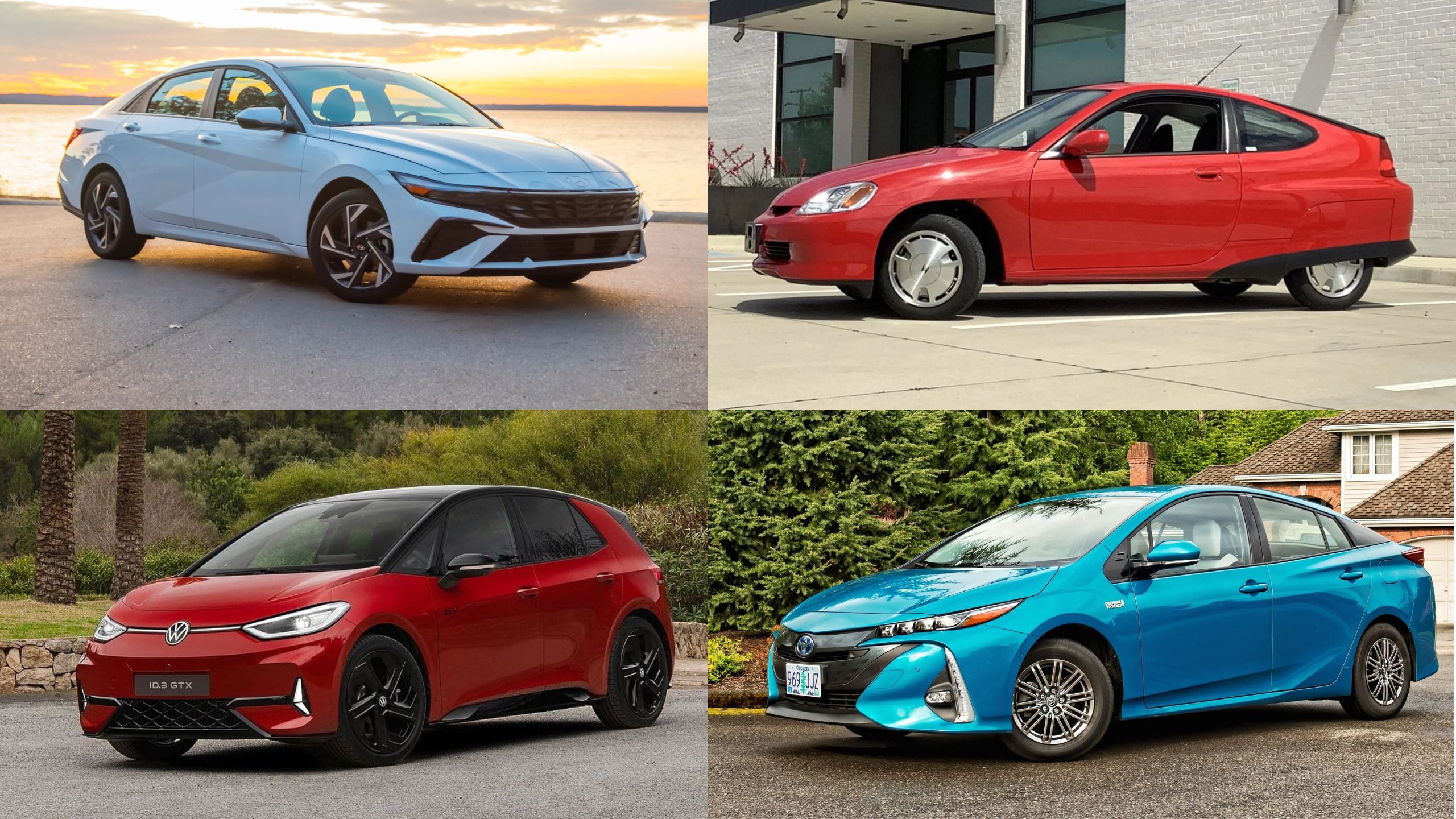In today’s automotive world, fuel efficiency remains a critical consideration for many consumers, particularly those shopping in the compact car segment.
While the market continues to shift toward SUVs and crossovers, compact cars maintain their relevance through exceptional fuel economy, affordable pricing, and increasingly sophisticated features.
However, not all compact cars are created equal when it comes to efficiency. Some models achieve remarkable mileage ratings that can significantly reduce long-term ownership costs and environmental impact, while others prioritize performance, luxury features, or aggressive styling at the expense of fuel economy.
This disparity creates an interesting spectrum within the compact car category from hyper-efficient hybrids and economical commuters that can exceed 50 mpg to performance-oriented hot hatches and luxury compacts that consume fuel at rates more typical of much larger vehicles.
Understanding where different models fall on this spectrum can help consumers make informed decisions based on their priorities, driving habits, and budget constraints.
This article examines five compact cars that offer exceptional fuel efficiency and five that sacrifice economy for other attributes, providing a comprehensive look at the trade-offs involved in these opposing approaches to compact car design.
5 Compact Cars With Outstanding Mileage
These fuel-sipping compact champions deliver exceptional efficiency without sacrificing the driving experience, proving that small cars can offer both economy and enjoyment.
Advanced powertrains and aerodynamic designs help these compact models achieve remarkable mileage figures that translate to fewer fill-ups and significant savings over time.
Whether going through urban streets or cruising highways, these compact efficiency stars stretch every gallon to impressive distances while maintaining practical utility for daily driving.
1. Toyota Prius
The Toyota Prius stands as the definitive icon of fuel efficiency in the compact car segment, having pioneered hybrid technology for the mass market over two decades ago.
Now in its fifth generation, the Prius has evolved from a quirky, efficiency-focused oddity into a sophisticated compact car that balances remarkable fuel economy with increasingly refined driving dynamics and technology features.
The latest model achieves an EPA-estimated 57 mpg in the city and 56 mpg on highways in its most efficient front-wheel drive configuration, figures that remain at the pinnacle of non-plug-in vehicles available today.
The Prius’s exceptional efficiency stems from its meticulously refined hybrid powertrain, which pairs a 2.0-liter four-cylinder Atkinson-cycle engine with two motor-generators and a lithium-ion battery pack.
This system produces a combined 196 horsepower a significant increase over previous generations allowing the current Prius to accelerate from 0-60 mph in around 7.1 seconds, dispelling the long-held notion that efficiency must come at the expense of adequate performance.
The system seamlessly transitions between electric, gasoline, and combined power sources, optimizing efficiency in real-time based on driving conditions.
Toyota’s hybrid expertise extends beyond the powertrain to numerous efficiency-enhancing technologies throughout the vehicle. The aerodynamic body design achieves a drag coefficient of just 0.27, reducing wind resistance at highway speeds.
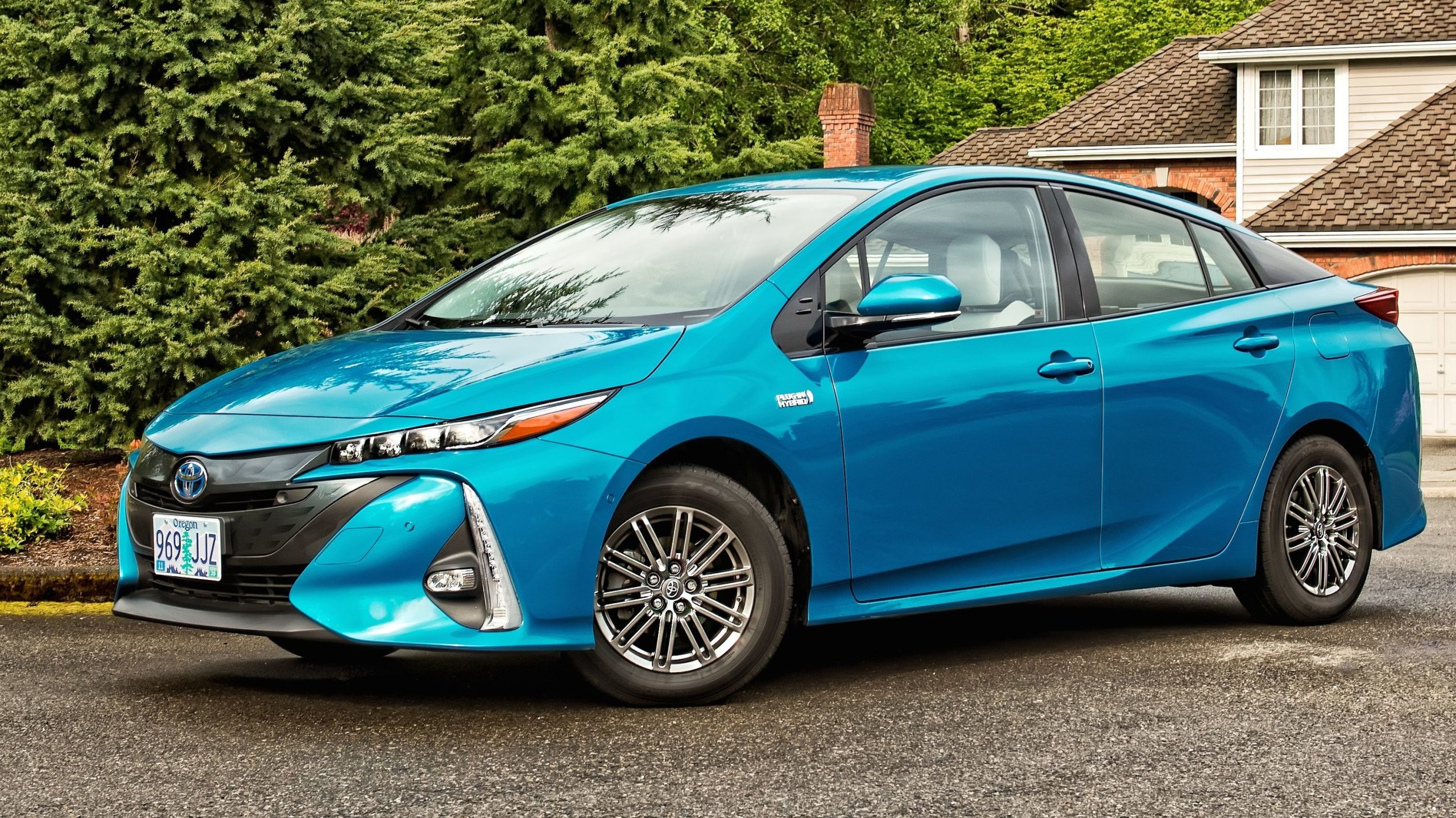
Low-rolling-resistance tires reduce friction without significantly compromising grip. An intelligent climate control system minimizes energy consumption while maintaining passenger comfort.
The regenerative braking system captures kinetic energy during deceleration, converting it to electricity rather than wasting it as heat. Inside, the Prius offers a surprisingly spacious cabin for a compact car, with comfortable seating for five and up to 23.8 cubic feet of cargo space with the rear seats in place, practical dimensions that make it viable as a primary family vehicle despite its efficiency focus.
The interior features an 8-inch touchscreen infotainment system (with a 12.3-inch version available on higher trims) that includes Apple CarPlay and Android Auto compatibility. Toyota’s Safety Sense 3.0 suite of driver assistance features comes standard, including adaptive cruise control, lane-keeping assistance, and automatic emergency braking.
With a starting price around $28,000, the Prius represents an excellent value proposition when considering its long-term fuel savings. While the purchase price exceeds that of some conventional compact cars, owners typically recoup this premium through reduced fuel costs over several years of ownership, particularly for high-mileage drivers.
The Prius also maintains excellent resale value, further enhancing its total cost of ownership advantages. For buyers prioritizing efficiency above all else in the compact segment, the Prius continues to set the standard against which all other fuel-efficient vehicles are measured.
2. Hyundai Elantra Hybrid
The Hyundai Elantra Hybrid represents one of the most compelling efficiency-focused options in the compact sedan market, achieving an impressive EPA-estimated 53 mpg city and 56 mpg highway in its most efficient Blue trim level.
What makes the Elantra Hybrid particularly noteworthy is how it delivers this exceptional fuel economy while maintaining the styling, features, and driving experience that have made the standard Elantra a segment standout.
Rather than adopting a distinctive “hybrid look” as some competitors do, the Elantra Hybrid integrates its efficiency technology seamlessly into an already excellent compact sedan package.
The hybrid powertrain combines a 1.6-liter four-cylinder Atkinson-cycle engine with a 32-kilowatt electric motor and a 1.32-kWh lithium-ion polymer battery, producing a combined 139 horsepower and 195 lb-ft of torque.
Unlike many hybrids that use continuously variable transmissions (CVTs), the Elantra Hybrid employs a six-speed dual-clutch automatic transmission that provides more engaging shift dynamics without significantly compromising efficiency.
This powertrain configuration allows the Elantra Hybrid to feel more responsive and conventional in daily driving compared to some hybrid competitors with CVTs.
Hyundai has incorporated numerous efficiency-enhancing features beyond the hybrid powertrain. An active air flap system in the front grille automatically adjusts airflow to optimize aerodynamics based on speed and cooling requirements.

The regenerative braking system captures energy during deceleration, with paddle shifters allowing the driver to adjust the regenerative braking intensity. An efficient heat pump climate control system reduces energy consumption compared to conventional air conditioning systems, particularly in cold weather operation.
Inside, the Elantra Hybrid offers a tech-forward interior with a standard 8-inch touchscreen (or optional 10.25-inch unit) with wireless Apple CarPlay and Android Auto connectivity. Higher trim levels feature a 10.25-inch digital instrument cluster that creates a connected dual-screen appearance.
The cabin provides 38.7 inches of rear legroom, impressive for the compact segment, and 14.2 cubic feet of trunk space, identical to the non-hybrid model.
Hyundai’s comprehensive warranty coverage enhances the Elantra Hybrid’s value proposition, with a 5-year/60,000-mile basic warranty, 10-year/100,000-mile powertrain warranty, and lifetime hybrid battery warranty for the original owner.
With a starting price around $24,500 for the base Blue trim and approximately $29,000 for the feature-rich Limited trim, the Elantra Hybrid commands only a modest premium over comparable non-hybrid models while delivering substantial fuel savings that quickly offset the initial cost difference for many drivers.
This combination of exceptional efficiency, competitive pricing, and comprehensive features makes the Elantra Hybrid one of the most well-rounded options for efficiency-conscious compact car shoppers.
3. Honda Insight
The Honda Insight represents Honda’s most focused approach to compact car efficiency, achieving an EPA-estimated 55 mpg city and 49 mpg highway through thoughtful engineering and hybrid technology.
Unlike many competitors that offer hybrid variants of existing models, the Insight was developed specifically as a hybrid-only vehicle, allowing Honda engineers to optimize every aspect of its design around efficiency without the compromises sometimes required when adapting conventional platforms.
At the heart of the Insight’s efficiency is Honda’s two-motor hybrid system, which pairs a 1.5-liter Atkinson-cycle four-cylinder engine with two electric motors and a lithium-ion battery pack.
This sophisticated system produces a combined 151 horsepower and operates differently than typical hybrid setups. In most driving conditions, the gasoline engine acts primarily as a generator, producing electricity to power the electric propulsion motor rather than directly driving the wheels.
This arrangement allows the system to operate more frequently in its most efficient modes, contributing to the Insight’s exceptional city fuel economy.
The Insight’s powertrain provides three distinct driving modes EV, Hybrid, and Engine that the system automatically selects based on driving conditions to maximize efficiency.
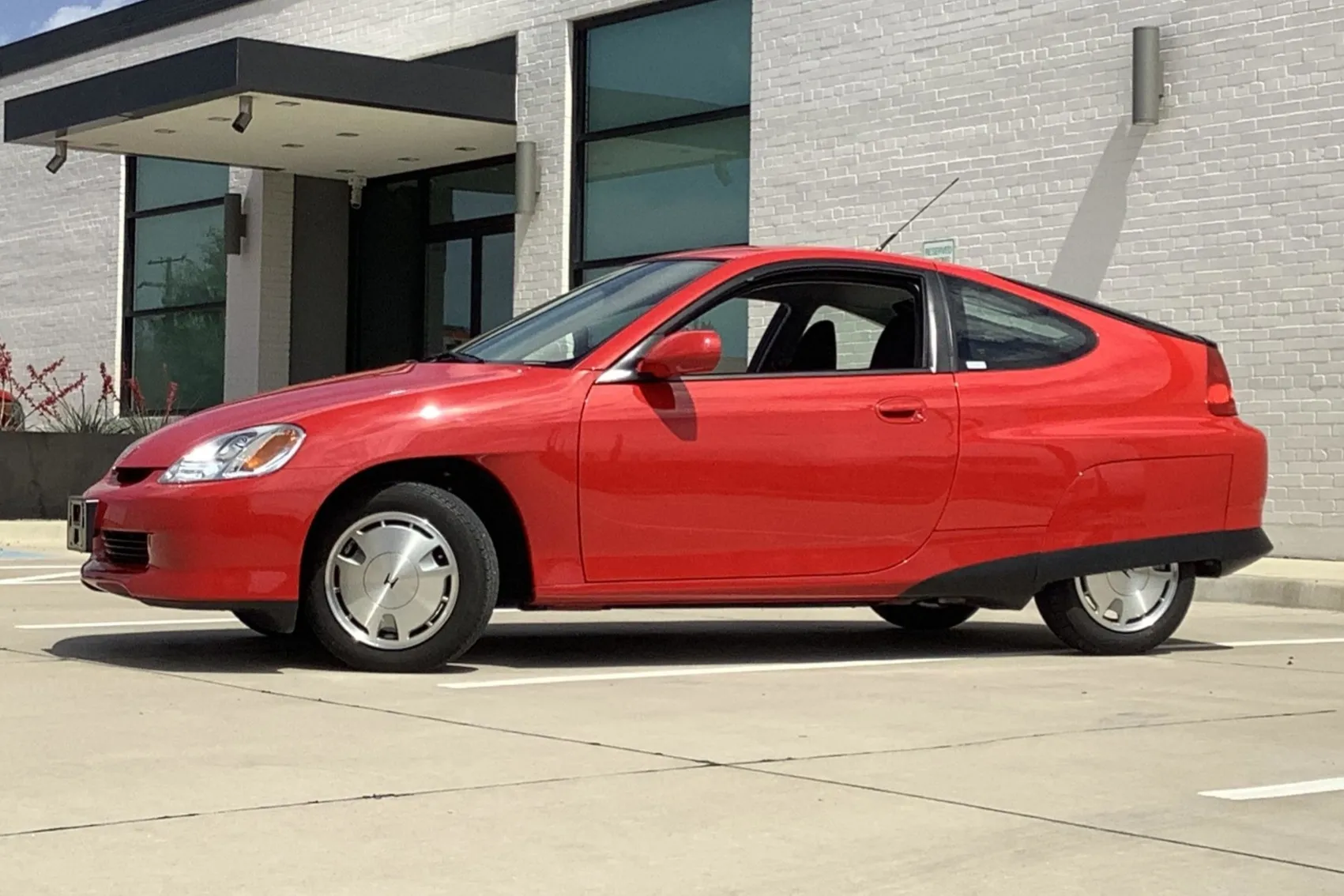
The driver can also select from three performance modes (ECON, Sport, and Normal) that adjust throttle response and climate control operation to prioritize either maximum efficiency or more engaging performance.
Steering wheel-mounted deceleration selectors allow the driver to adjust the intensity of regenerative braking, capturing more energy during deceleration while enabling one-pedal driving in some conditions.
Inside, the Insight offers a surprisingly premium cabin for an efficiency-focused vehicle. The thoughtfully designed interior features high-quality materials, comfortable seating for five, and a traditional sedan layout that avoids the futuristic but potentially polarizing designs found in some dedicated hybrid models.
The 8-inch touchscreen infotainment system includes Apple CarPlay and Android Auto integration, while the available Honda Sensing suite provides comprehensive driver assistance features including adaptive cruise control, lane-keeping assistance, and traffic sign recognition.
Practicality hasn’t been sacrificed at the altar of efficiency, as the Insight provides 15.1 cubic feet of trunk space, generous for the compact sedan segment and identical to many non-hybrid competitors.
The rear seats fold in a 60/40 split to accommodate longer items when needed, a feature sometimes compromised in hybrid sedans due to battery placement.
With a starting price around $26,000, the Insight positions itself as a premium offering in the compact hybrid segment, justified by its refined driving experience, comprehensive feature set, and exceptional build quality.
For buyers seeking efficiency without obvious compromises in styling, performance, or practicality, the Insight offers one of the most well-rounded packages available, proving that outstanding fuel economy doesn’t require sacrificing the qualities that make a compact car enjoyable to live with daily.
4. Volkswagen ID.3
The Volkswagen ID.3 represents a fundamentally different approach to efficiency in the compact car segment as a purpose-built electric vehicle designed from the ground up around its battery and electric drivetrain.
While not yet available in all markets (notably absent from North America as of early 2025), the ID.3 achieves the equivalent of approximately 126 MPGe in combined driving according to the WLTP testing cycle, positioning it among the most energy-efficient compact cars ever produced for mass consumption.
The ID.3’s efficiency stems from Volkswagen’s MEB platform, a modular electric vehicle architecture that optimizes weight distribution, aerodynamics, and packaging efficiency.
The most efficient “Pure” trim features a 45 kWh battery providing approximately 217 miles of range, while larger battery options extend range to over 300 miles for drivers prioritizing distance over maximum efficiency.
The rear-mounted electric motor produces 148 horsepower and 229 lb-ft of torque in base configuration, delivering instant responsiveness and acceleration from 0-60 mph in approximately 8.5 seconds, respectable performance balanced with outstanding efficiency.
Several engineering decisions enhance the ID.3’s efficiency beyond its electric powertrain. The aerodynamic design achieves a drag coefficient of just 0.27, reducing energy consumption at highway speeds.

An advanced heat pump climate control system consumes significantly less energy than traditional electric resistance heating, extending range in cold weather conditions.
The regenerative braking system captures up to 90% of kinetic energy during deceleration, returning it to the battery rather than dissipating it as heat through brake friction.
Inside, the ID.3 showcases how electric architecture enables superior space utilization in a compact footprint. Despite exterior dimensions similar to a Golf, the ID.3 offers interior space comparable to a Passat thanks to its extended wheelbase and the absence of a conventional engine compartment.
The minimalist dashboard features a 10-inch touchscreen (or optional 12-inch display) and a small digital instrument cluster mounted to the steering column. The floating center console provides versatile storage options without the transmission tunnel intrusion found in conventionally powered vehicles.
Practicality remains excellent with 13.9 cubic feet of cargo space behind the rear seats, expanding to 50.6 cubic feet with seats folded figures that exceed many compact hatchbacks despite the ID.3’s battery packaging requirements.
The flat floor throughout the cabin enhances passenger comfort, particularly for center rear-seat occupants. With a starting price equivalent to approximately $32,000 (varying by market and excluding potential incentives), the ID.3 commands a premium over conventional compact cars but offers substantially lower operating costs through reduced energy consumption and maintenance requirements.
For drivers with access to home charging, the convenience of “refueling” at home, combined with minimal scheduled maintenance needs, creates a compelling ownership proposition beyond the vehicle’s impressive efficiency metrics.
Also Read: 5 Vehicles That Thrive in Traffic and 5 That Overheat Fast
5. Lexus UX 250h
The Lexus UX 250h demonstrates that exceptional fuel efficiency can coexist with luxury appointments and brand prestige in the compact crossover segment.
Achieving an EPA-estimated 43 mpg city and 41 mpg highway, the UX 250h delivers fuel economy that rivals dedicated hybrid sedans while offering the raised seating position and upscale amenities that many consumers prefer.
This combination makes it a uniquely positioned vehicle for buyers unwilling to compromise on either efficiency or luxury. The UX 250h employs Toyota’s proven fourth-generation hybrid system, pairing a 2.0-liter four-cylinder engine with two electric motor-generators and a nickel-metal hydride battery to produce a combined 181 horsepower.
The available all-wheel drive configuration adds a third electric motor at the rear axle, providing on-demand traction without a mechanical connection to the engine.
This system operates seamlessly, transitioning between electric, gasoline, and combined power sources without driver intervention, optimizing efficiency across varied driving conditions.
Lexus engineers have incorporated numerous efficiency enhancements beyond the hybrid powertrain. The aerodynamic shape achieves a drag coefficient of 0.33—impressive for a crossover—with features like wheel arch moldings and stabilizing fins reducing air turbulence.

The climate control system includes S-Flow technology that detects which seats are occupied and directs airflow only to those areas, reducing energy consumption.
The Predictive Efficient Drive function uses GPS data and learned driver patterns to optimize hybrid system operation, enhancing efficiency on frequently traveled routes.
Inside, the UX 250h delivers the refined experience expected from the Lexus brand. The cabin features high-quality materials throughout, including available NuLuxe synthetic leather upholstery and Washi paper-inspired dashboard textures inspired by traditional Japanese crafts.
The driver-focused cockpit includes a 7-inch digital instrument display (or optional 10.3-inch split-screen multimedia display) and intuitive controls positioned for minimal distraction.
The Lexus Climate Concierge system coordinates heating and cooling functions across multiple systems for optimized comfort with minimal energy use.
Cargo capacity is modest at 17.1 cubic feet behind the rear seats, reflecting the UX’s compact dimensions and battery placement. However, the 60/40-split folding rear seats provide flexibility for occasional larger items.
Standard safety features include the comprehensive Lexus Safety System+ 2.0 with pre-collision detection, lane-keeping assistance, and adaptive cruise control.
With a starting price around $36,000, the UX 250h positions itself as an entry point to the Lexus brand while offering efficiency metrics that exceed many mainstream compact cars.
This combination attracts buyers seeking luxury touches and brand prestige without the typical fuel economy penalties associated with premium vehicles.
The UX 250h demonstrates that outstanding mileage can be achieved without sacrificing the refinement, technology, and status that luxury buyers expect, expanding the appeal of high-efficiency vehicles to a broader audience.
5 Compact Cars That Drain Your Tank
Despite their small footprints, these compact disappointments consume fuel at rates rivaling much larger vehicles, betraying the efficiency expected from their modest dimensions.
Poor engineering choices and outdated technology plague these compact gas-guzzlers, resulting in frequent and costly trips to the pump that quickly eliminate any initial purchase savings.
Drivers expecting economical operation from these small cars face an unpleasant surprise when monitoring their fuel consumption, proving that compact size doesn’t always guarantee efficiency.
1. Subaru WRX
The Subaru WRX stands as an unapologetic performance machine in the compact car segment, prioritizing driving excitement and all-weather capability over fuel economy concerns.
With EPA ratings of just 19 mpg city and 26 mpg highway for manual transmission models (slightly better at 21/29 mpg for the automatic), the WRX consumes substantially more fuel than most compact cars.
However, this thirsty nature is considered an acceptable trade-off by enthusiasts who prize the vehicle’s rally-bred performance characteristics and distinctive driving experience.
At the heart of the WRX’s performance-first philosophy is a turbocharged 2.4-liter boxer four-cylinder engine producing a robust 271 horsepower and 258 lb-ft of torque.
This horizontally opposed engine layout contributes to the vehicle’s low center of gravity but introduces inherent efficiency challenges compared to conventional inline engines. The turbocharger provides substantial midrange torque but demands premium fuel for optimal performance, another cost premium beyond the raised consumption rate.
The standard six-speed manual transmission prioritizes engagement and control over efficiency, with closely spaced gear ratios optimized for acceleration rather than economy.
The WRX’s standard symmetrical all-wheel drive system represents another conscious choice favoring performance over efficiency. Unlike many modern AWD systems that primarily operate in front-wheel drive until slippage is detected, Subaru’s system continuously powers all four wheels, providing superior traction and handling dynamics at the expense of increased drivetrain friction and weight.
The system includes a viscous coupling center differential that splits power 50/50 between front and rear axles by default, but can adjust distribution based on conditions.
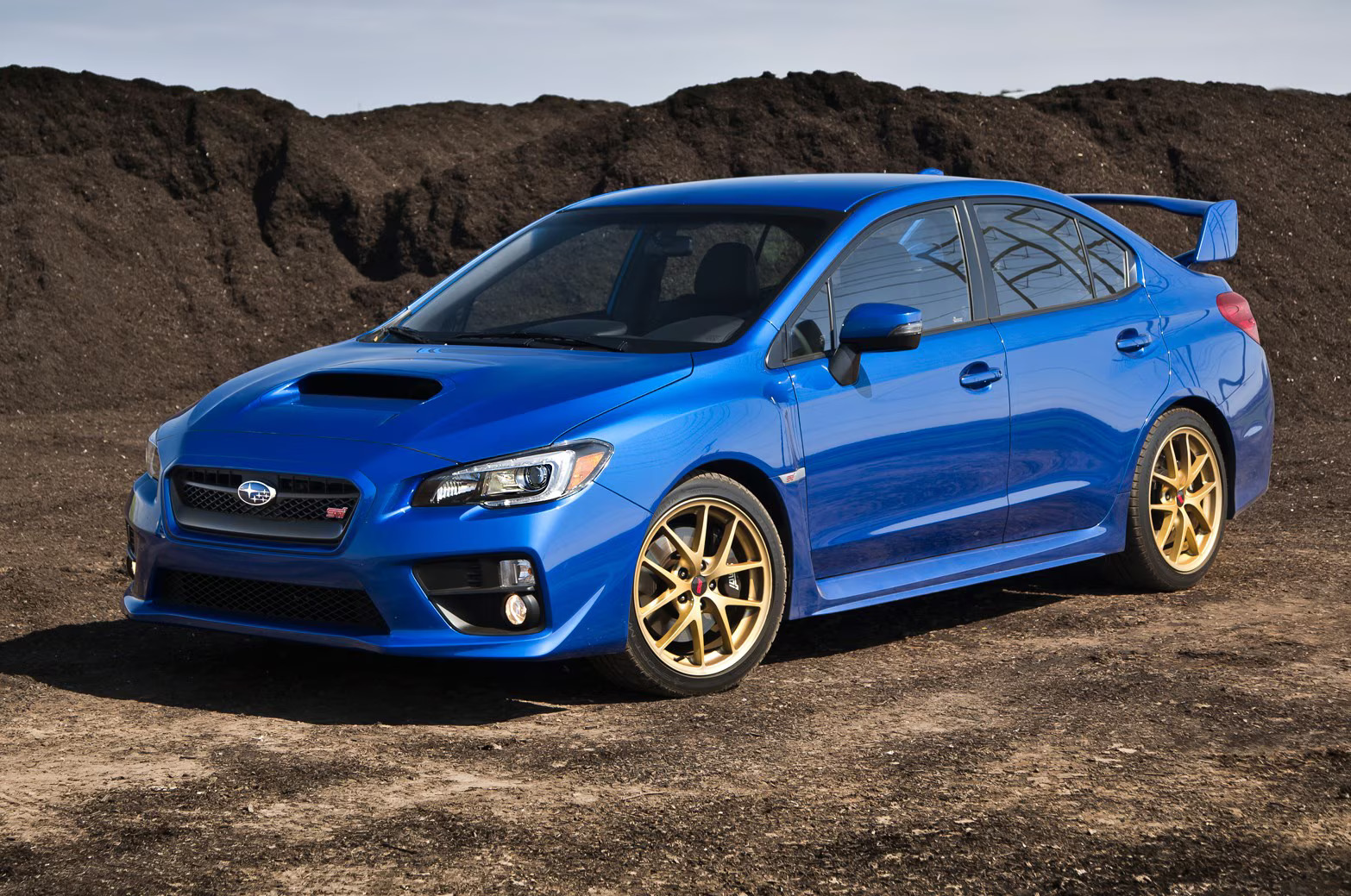
The vehicle’s performance-oriented suspension, with firm spring rates and substantial anti-roll bars, prioritizes cornering capability and driver feedback over the comfort-focused, efficiency-enhancing soft suspensions found in many economy-focused compacts.
Wide 245/40R18 performance tires provide excellent grip but increase rolling resistance compared to the narrower, harder compound tires typically found on efficiency-focused vehicles.
Inside, the WRX offers sport seats with substantial bolstering, a leather-wrapped flat-bottom steering wheel, and aluminum pedals that emphasize its performance intentions.
The available 11.6-inch vertical touchscreen infotainment system provides modern connectivity options, while driver assistance features are available for those who want them, though many WRX enthusiasts specifically seek out lower trims with fewer electronic interventions that might dilute the raw driving experience.
With a starting price around $31,000, the WRX commands a premium over efficiency-focused compacts but offers performance credentials that few vehicles at any price point can match, particularly in adverse weather conditions.
For enthusiasts who prioritize driving engagement, acceleration, and all-weather capability over fuel economy, the WRX’s thirsty nature represents a conscious choice rather than a drawback, part of the character that has created one of the most devoted owner communities in the automotive world.
2. Mercedes-AMG CLA 45
The Mercedes-AMG CLA 45 epitomizes the concept of a compact car that prioritizes extreme performance over efficiency considerations. With EPA ratings of just 20 mpg city and 27 mpg highway, this small Mercedes consumes fuel at a rate more typical of much larger vehicles.
However, these unimpressive efficiency figures accompany performance credentials that would have been considered supercar territory just a decade ago, reflecting the vehicle’s uncompromising focus on delivering an exhilarating driving experience within a compact footprint.
The centerpiece of the CLA 45’s performance-focused engineering is its hand-built 2.0-liter turbocharged four-cylinder engine the most powerful production four-cylinder in the world producing an astonishing 382 horsepower and 354 lb-ft of torque.
This extraordinary output from such a small displacement engine comes at a significant efficiency cost, requiring premium fuel and sophisticated cooling systems to manage the thermal stresses of producing over 190 horsepower per liter.
The “one man, one engine” philosophy extends to each powerplant being assembled by a single AMG technician who signs the engine cover upon completion.
The CLA 45’s eight-speed dual-clutch automatic transmission prioritizes lightning-fast shifts and launch control functionality over the efficiency-focused programming found in more economical vehicles.
Similarly, the sophisticated 4MATIC+ all-wheel drive system features torque vectoring capability and a drift mode that can send up to 100 percent of power to the rear wheels technology focused on dynamic handling rather than minimizing energy losses through the drivetrain.

The vehicle’s aerodynamic design elements, including the prominent front splitter, rear diffuser, and optional aerodynamic package with a fixed rear wing, are engineered to enhance downforce and stability at high speeds rather than reduce drag for improved fuel economy.
The substantial 19-inch wheels with wide performance tires significantly increase rolling resistance compared to the narrower, harder compound tires found on efficiency-focused compacts.
Inside, the CLA 45 features heavily bolstered AMG performance seats, a thick-rimmed steering wheel with drive mode selectors, and the latest MBUX infotainment system with AMG-specific displays showing performance metrics like g-forces, lap times, and engine data.
The cabin’s premium materials and technology features add weight compared to more basic compact cars, further compromising efficiency in favor of luxury appointments.
With a starting price around $60,000 that can easily exceed $70,000 with options, the CLA 45 occupies a rarified position in the compact segment, appealing to buyers for whom performance and brand prestige take absolute priority over efficiency considerations.
For this select audience, the vehicle’s ability to accelerate from 0-60 mph in just 4.0 seconds and reach an electronically limited top speed of 155 mph (or 168 mph with the optional AMG Driver’s Package) justifies both its premium price and its thirsty nature.
3. Mini John Cooper Works GP
The Mini John Cooper Works GP represents perhaps the most extreme interpretation of the performance-focused compact car, sacrificing not only fuel efficiency but also practicality in pursuit of track-ready performance.
With EPA ratings of just 24 mpg city and 30 mpg highway, disappointing figures for a vehicle with such a small footprint, the JCW GP makes no pretense about its priorities. Limited to just 3,000 units worldwide, this special edition Mini abandons any pretense of economy in favor of creating the most track-capable production Mini ever offered.
Under the hood lies a heavily boosted 2.0-liter turbocharged four-cylinder engine producing 301 horsepower and 332 lb-ft of torque extraordinary figures for such a lightweight vehicle.
This potent powerplant enables the JCW GP to accelerate from 0-60 mph in just 5.2 seconds despite sending power only to the front wheels. The engine requires premium fuel and features additional cooling capacity to handle the thermal loads associated with track use, further compromising efficiency.
Unlike regular Mini models that offer various driving modes, including an efficiency-focused “Green” setting, the JCW GP is unapologetically tuned for performance at all times.
The eight-speed automatic transmission (no manual is offered) features aggressive shift programming optimized for rapid acceleration rather than fuel conservation.
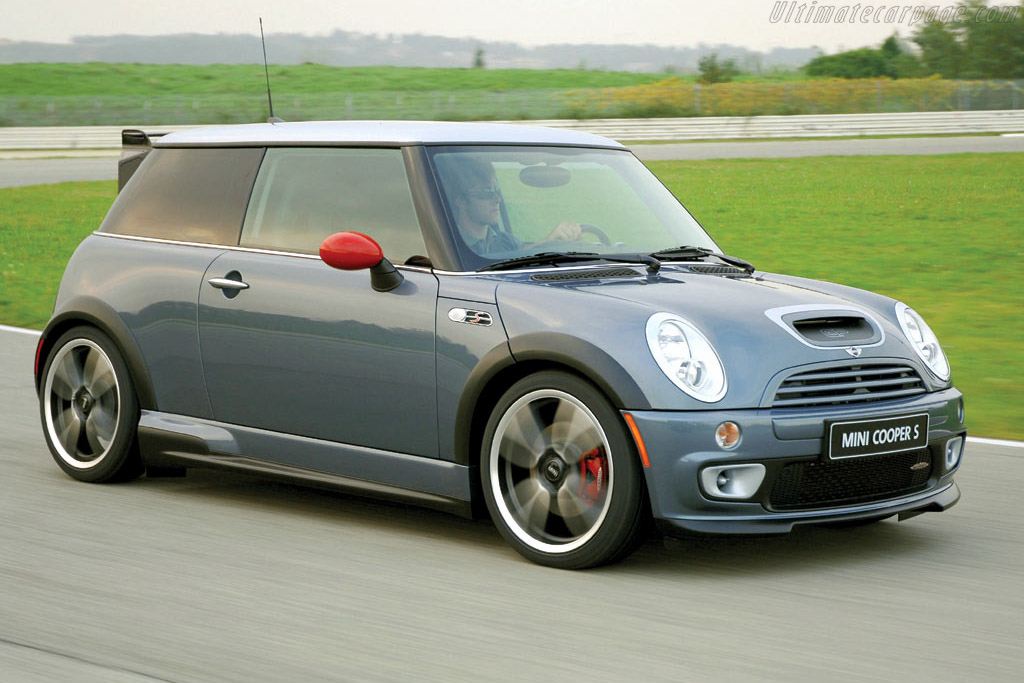
The limited-slip differential essential for managing the substantial torque through the front wheels adds mechanical complexity and weight while increasing drivetrain friction compared to simpler setups in efficiency-focused compacts.
The track-tuned suspension, with adjustable coilovers that lower the ride height by 10mm compared to the standard JCW, prioritizes cornering capability and feedback over the comfort-oriented, efficiency-enhancing soft suspensions found in economy-focused vehicles.
Aerodynamic elements including the massive rear wing, aggressive front splitter, and underbody panels, are designed purely to enhance downforce and stability at high speeds rather than reduce drag for improved economy.
The GP-specific 18-inch forged wheels and Hankook high-performance tires maximize grip at the expense of increased rolling resistance compared to the harder compound, lower grip tires found on efficiency-optimized models.
Inside, the pursuit of performance has led to the removal of the rear seats entirely, replaced by a prominent red strut brace that enhances chassis rigidity.
The front seats feature aggressive bolstering and minimal padding, while the steering wheel includes a 12 o’clock marker for precise wheel positioning during track driving.
The spartan interior eschews many comfort features that might add weight, though a digital instrument cluster and 8.8-inch touchscreen provide modern connectivity options.
With a starting price around $45,000 when it was available new, the JCW GP commanded nearly double the cost of a base Mini Cooper while offering significantly worse fuel economy.
For the dedicated enthusiasts who secured one of the limited production run, this compromise was entirely acceptable given the vehicle’s exceptional performance capabilities and exclusivity qualities that take absolute priority over efficiency considerations for this specialized audience.
4. Alfa Romeo Giulietta Quadrifoglio
The Alfa Romeo Giulietta Quadrifoglio (sometimes called the Giulietta QV in certain markets) represents the passionate Italian approach to compact car design, where emotional appeal and driving experience take clear precedence over efficiency considerations.
With fuel economy ratings equivalent to approximately 21 mpg city and 30 mpg highway, the Giulietta Quadrifoglio consumes substantially more fuel than mainstream compact hatchbacks, reflecting its performance-focused engineering and the heritage expectations associated with Alfa Romeo’s storied cloverleaf badge.
At the heart of the Giulietta Quadrifoglio lies a 1.75-liter turbocharged four-cylinder engine producing 240 horsepower and 251 lb-ft of torque modest figures by today’s standards but delivered with a distinctive character that prioritizes emotional engagement over outright efficiency.
The engine features direct injection and variable valve timing but eschews efficiency-focused technologies like cylinder deactivation or aggressive start-stop systems that might compromise the responsive, high-strung nature Alfa Romeo enthusiasts expect.
The distinctive engine note, enhanced by the performance exhaust system, represents another conscious choice favoring emotional appeal over the quieter, more refined operation typically associated with efficiency-optimized powertrains.
The six-speed manual transmission (the preferred choice for enthusiasts) features closely spaced ratios optimized for keeping the turbocharged engine in its power band rather than the widely spaced gearing found in economy-focused vehicles.

The “DNA” drive mode selector includes Dynamic, Natural, and All-Weather settings that adjust throttle response, steering weight, and stability control intervention but notably lacks an “Eco” mode found in many modern compacts, underscoring the vehicle’s performance-first philosophy.
The Quadrifoglio’s suspension tuning, with stiffer springs, performance-calibrated dampers, and larger anti-roll bars than standard Giulietta models, prioritizes handling precision and driver feedback over the comfort-oriented, efficiency-enhancing soft suspensions typical in economy-focused compacts.
The Brembo brake system with four-piston front calipers provides exceptional stopping power but adds unsprung weight compared to simpler setups in more efficiency-focused vehicles.
Inside, the Quadrifoglio features heavily bolstered sport seats with leather and Alcantara upholstery, aluminum pedals, and unique instrumentation reflecting its performance intent.
The cabin prioritizes driver engagement with a focus on properly positioned controls and excellent visibility, though material quality and technology features lag behind some competitors, another indication that driving experience takes precedence over other considerations in the vehicle’s design philosophy.
With a price equivalent to approximately $40,000 in markets where it was sold (the model was never officially imported to North America), the Giulietta Quadrifoglio commanded a significant premium over mainstream compact hatchbacks while offering substantially lower fuel economy.
For the passionate enthusiasts drawn to Alfa Romeo’s unique blend of style, heritage, and driving dynamics, this compromise was entirely acceptable, even expected as part of the emotional ownership experience that transcends practical considerations like fuel efficiency.
5. Ford Focus RS
The Ford Focus RS represents a no-compromise approach to performance engineering in the compact car segment, prioritizing extraordinary capability and driving excitement over considerations of fuel economy.
With EPA ratings of just 19 mpg city and 26 mpg highway, the Focus RS consumes substantially more fuel than the standard Focus models from which it evolved.
However, this thirsty nature is an expected consequence of the engineering decisions that transform a practical compact hatchback into a rally-inspired performance machine capable of embarrassing many dedicated sports cars costing twice as much.
At the heart of the Focus RS lies a 2.3-liter turbocharged EcoBoost four-cylinder engine producing 350 horsepower and 350 lb-ft of torque (with up to 347 lb-ft available during brief overboost periods).
Despite the “Eco” in its name, this engine is fundamentally designed for performance, featuring a twin-scroll turbocharger, substantial intercooling, and high-pressure direct injection to maximize power density rather than efficiency.
The engine requires premium fuel and incorporates additional cooling measures to handle the thermal stresses of high-performance driving, further compromising economy.
The six-speed manual transmission (the only option offered) features closely spaced ratios optimized for acceleration and engagement rather than the tall overdrive gears found in efficiency-focused vehicles.
The clutch and flywheel assembly is substantially reinforced to handle the engine’s considerable torque output, adding rotational mass that impacts efficiency.
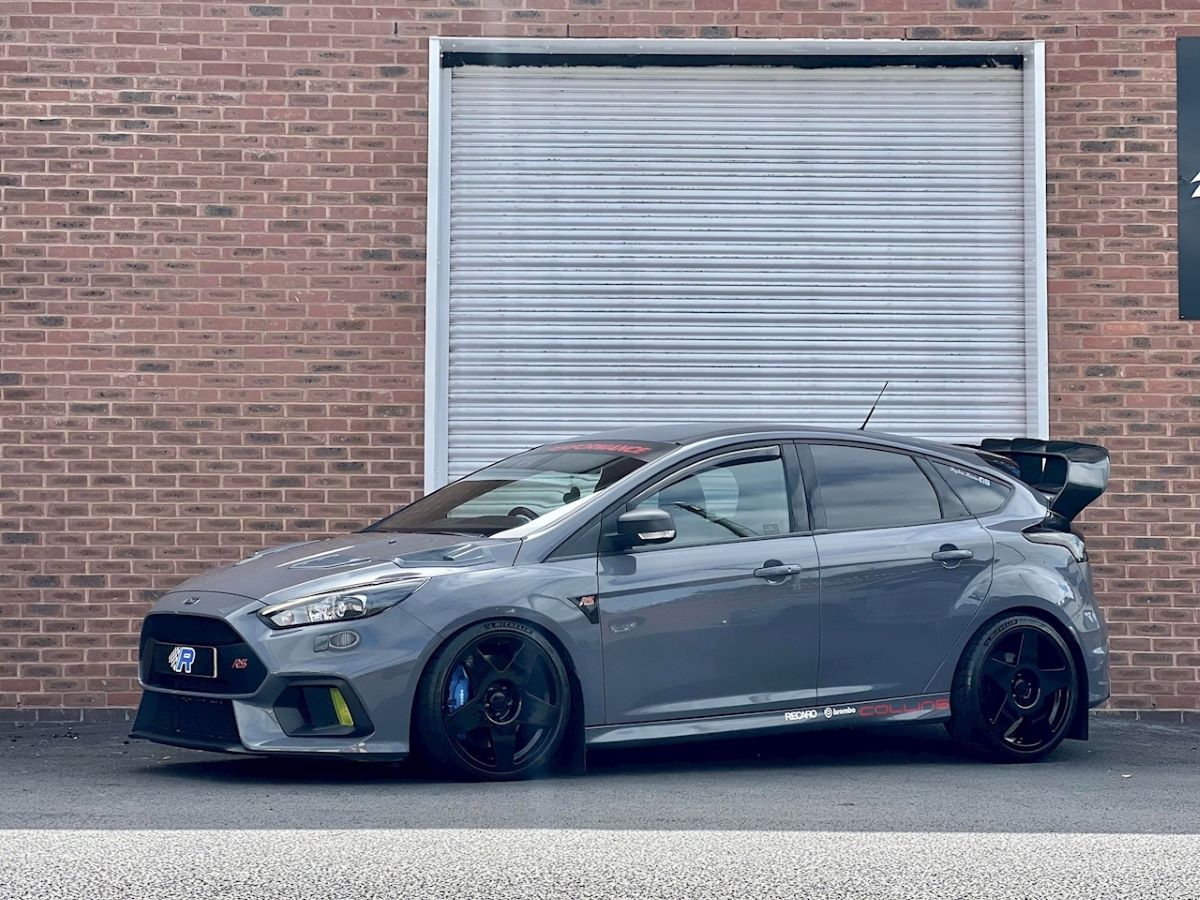
The transmission incorporates aggressive sound symposers that amplify engine noise in the cabin—another indication that emotional engagement takes priority over refined, efficiency-focused operation.
The Focus RS’s sophisticated all-wheel drive system represents perhaps the clearest example of performance taking precedence over efficiency. Unlike the front-wheel drive layout of standard Focus models, the RS employs a complex AWD system featuring torque vectoring and dynamic torque split between the front and rear axles.
The system can send up to 70 percent of power to the rear wheels and includes a controversial but entertaining “Drift Mode” that modifies torque distribution to facilitate controlled slides. This hardware adds substantial weight and mechanical complexity while increasing drivetrain friction compared to simpler front-wheel drive configurations.
Inside, the Focus RS features heavily bolstered Recaro sport seats, a flat-bottom steering wheel, and unique instrumentation including gauges for oil temperature, oil pressure, and turbocharger boost pressure features that cater to enthusiast drivers rather than efficiency-minded commuters.
The cabin retains the practicality of the standard Focus with seating for five and 19.9 cubic feet of cargo space behind the rear seats, though the stiffer suspension and louder exhaust significantly impact comfort and refinement.
With a starting price around $36,000 when it was last available new, the Focus RS commanded nearly double the cost of a base Focus while offering substantially worse fuel economy.
For the enthusiasts who sought its unique combination of everyday usability and extraordinary performance capabilities, this compromise was entirely acceptable even expected as part of the experience of owning one of the most capable and engaging compact cars ever produced.
Also Read: 5 Commuter Cars That Go the Distance and 5 That Stall in Traffic

